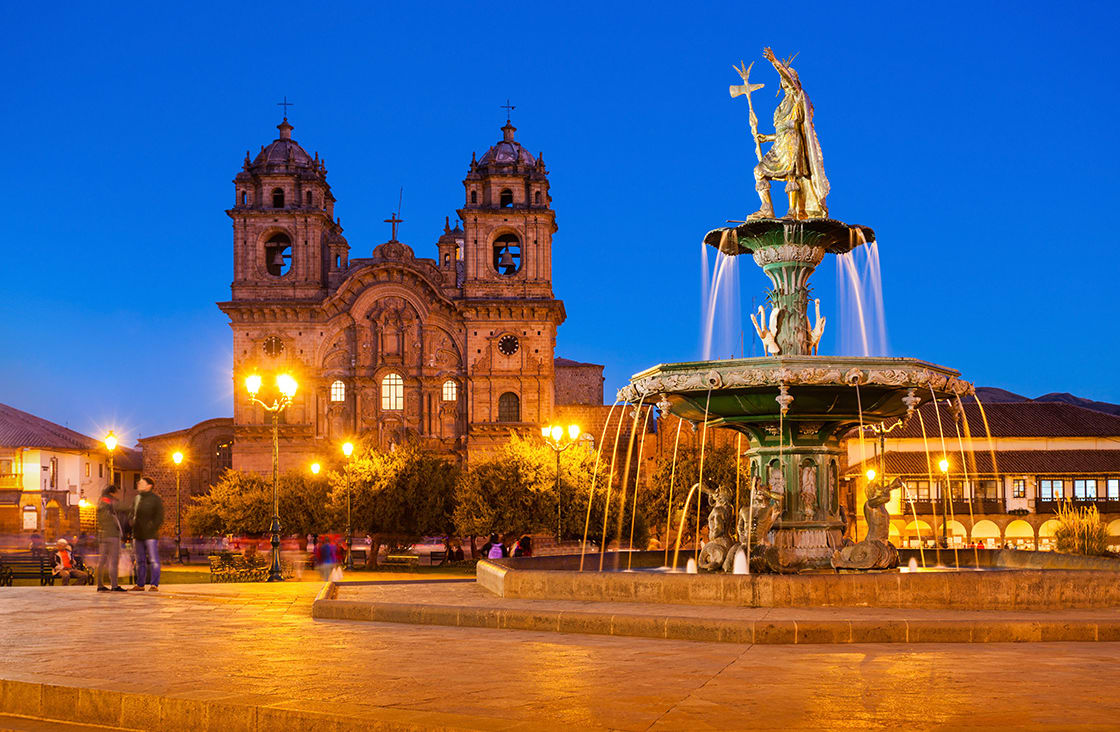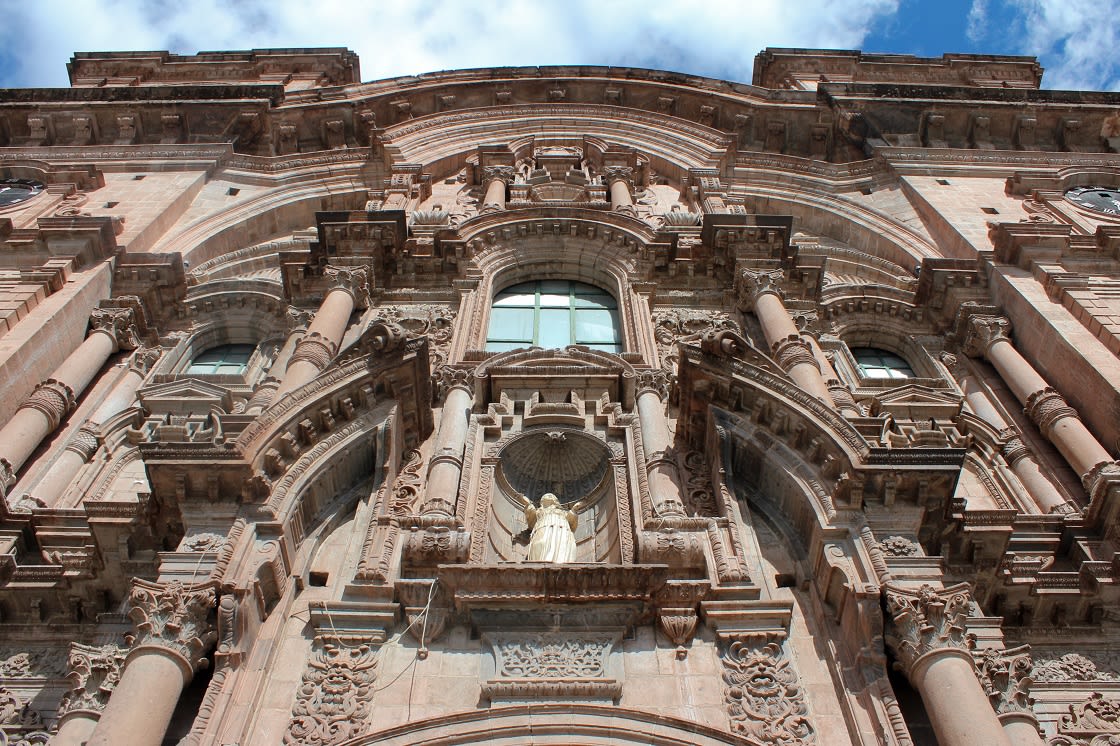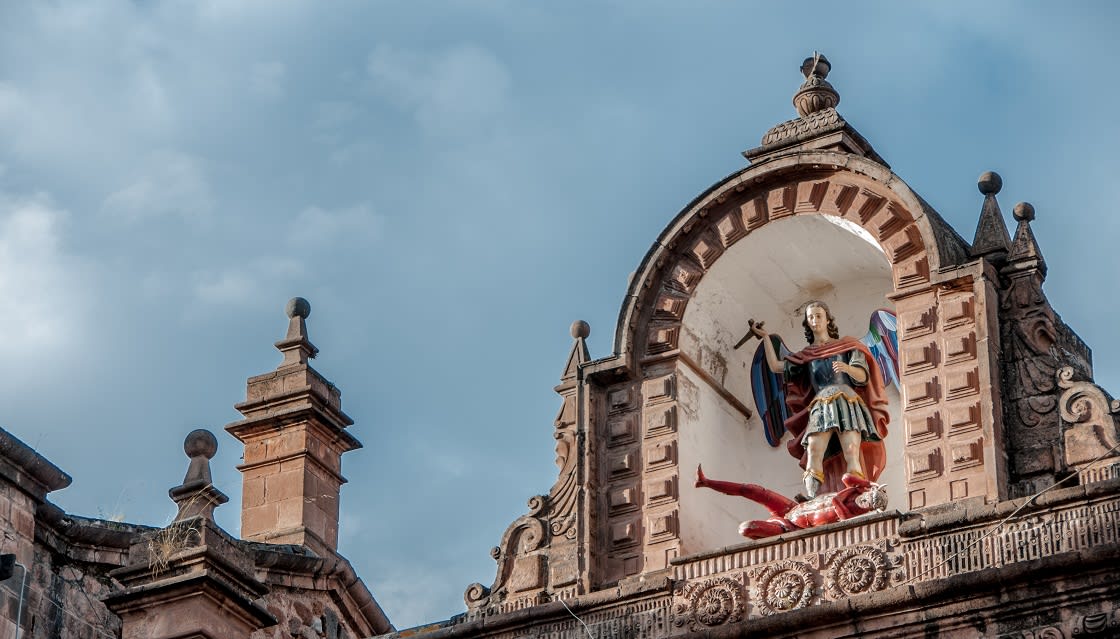
Home to countless architectural relics and historical sights, the city of Cusco is teeming with attractions that offer visitors a glimpse into its rich history. The city’s main square, the Plaza de Armas and the imposing Cusco Cathedral is the heart of it all, in both location and significance.
Known as the “square of the warrior” in the Inca era, the plaza has been the setting for many of the city’s most important events, and Cusco Cathedral has been a central character and witness to it all. Here’s a brief history of Cusco Cathedral with some useful tips on what to look out for when you visit, and a little background on some of the other noteworthy churches in Cusco’s main square:

Part Of The Facade Of Cusco Cathedral
The Cathedral Basilica of the Assumption of the Virgin – better known as Cusco Cathedral – was actually the second religious building (after the Church of Triumph) that the Jesuits began building in Cusco’s main square, yet it was the last to be completed. Construction of the Cusco Cathedral began in 1559, and was completed almost one hundred years later in 1654.
The Cusco Cathedral was built upon the foundations of a sacred Inca site (a theme that would continue). Designed in the shape of a Latin cross, the location was chosen atop the foundations of kiswarkancha, with the purpose of removing the Inca religion from Cusco and subsequently replacing it with Spanish Catholic Christianity. Formerly, kiswarkancha acted as the Inca palace of Viracocha, the ruler of the kingdom of Cusco almost a full century before the Spanish conquistadores arrived.
The Cathedral is built in Gothic-Renaissance style, with evidence of baroque influence in the façade. Because most of Cusco’s population was still of Quechua Inca descent at the time of construction, the Spaniards used Inca labor to build the cathedral and this becomes apparent when you look carefully as you can see much of their religious symbolism incorporated into the church, such as the head of the jaguar carved into the front doors.
Its bell – the Maria Angola Bell – is also noteworthy. At 2.15 meters tall and 5980 kg in weight, it is only rung on special occasions, and is claimed to be heard from more than 20 miles away.
Don’t miss the colonial art found here, with many work from the Cusco school that are known for their decorative combination of 17th-century European devotional painting styles, paired with the colors and iconography of indigenous Andean art. One classic example of this is the repeated portrayal of the Virgin Mary wearing a mountain-shaped skirt with a river decorating the hem, relating her to the sacred Pachamama (Mother Earth).
Make sure to catch a glimpse of The Last Supper by Quechua artist Marcos Zapata. The popular depiction of the last supper has a Cusco flair, with Andean ceremonial food replacing the more-often portrayed dishes upon the table. Look for the roast cuy (guinea pig) on the table, not unlike those you’ll be able to dine on all throughout Cusco.
The cathedral is also home to the oldest surviving painting in Cusco. It depicts the city during the great earthquake of 1650, in which a precious crucifix called El Senor de los Temblores was prayed before to stop the earthquake. It miraculously did, and you can see the exact crucifix to the right of the door leading into the Church of the Triumph, or during the Holy Monday parade every year in which he travels through the city to be worshipped by the faithful.
Visitors can enter the church using the entrance at the Sacred Family Church, just to the left of the cathedral’s facade. Cusco Cathedral is open Monday through Sunday, from 10 am to 6 pm and costs 25 soles (approximately $7).
The Church of Triumph (Iglesia del Triunfo) was the first of the churches to be built upon Cusco’s main square, with construction beginning in 1536, just three years after the Spanish conquistadores arrived in Cusco. The Jesuits built the church over Suntur Wasi, an Inca ceremonial building, armory and heraldry center attached to the palace of Viracocha. It is the first Christian Church to have been built in all of Cusco.
The name of the Church of Triumph comes from a surprising Spanish victory in a battle against the Incas, in which the Spanish managed to fight back win and just as they were on the verge of defeat. The devout Catholics believed that Saint James the Greater (the patron saint of Spain) descended from heaven to drive back the Incas. Now, you will see a statue of St. James atop a horse inside this very church, depicted slaying an Inca.
Inside you’ll also find a vault of the remains of the famous Inca chronicler Garcilaso de la Vega. De la Vega was born in Cusco in 1539 and died in Cordoba, Spain in 1616. His remains were returned to the city of Cusco in 1978 by King Juan Carlos of Spain, and can now be found here.

Church Of Society Of Jesus, Located In The Main Square Of Cusco
The Church of the Society of Jesus (Iglesia de la Compania de Jesus) was the third church to be built in Cusco’s Plaza de Armas, with construction beginning in 1576 by the Jesuits atop the foundations of Amarucancha (the palace of Inca ruler Wayna Qhapaq). Its construction quickly became the center of a heated dispute, as the Jesuits were determined to make it the most magnificent church in all of Cusco, while the archbishop of Cusco believed that it should not be allowed to compete with the cathedral as the seat of the diocese. Both parties sent letters to Pope Paul III in Rome in an appeal for their side, yet by the time his message reached South America the church was nearly complete.
True to their word, the Jesuits succeeding in building one of the most ornate churches in the region, with the church famous for its incredible baroque façade, notoriously rivaling the Cathedral of Cusco after a conflict over just how decadent it could be built. You’ll also find Peru’s biggest altar here, resting beneath an impressive domed ceiling.
Let a local student guide you through the church (tips appreciated), and make sure to ask to see the splendid view from the choir on the 2nd floor.
Also worth noting are two large canvases just inside the main door, which depict early marriages in Cusco. The period detail is exquisite, and the pieces are quite unique amongst the wealth of art within Cusco’s churches.
The Cusco Cathedral and other churches of Cusco’s main square offer visitors a fascinating glimpse into Cusco’s tumultuous history, from the time of the Incan temples to the colonial churches and their modern-day rituals that continue today. For all those heading to the former Inca capital, a visit to Cusco Cathedral at the least is a must.
While Rainforest Cruises aim to provide accurate and up-to-date information, we make no representations as to the accuracy or completeness of any information herein or found by following any link on this site. Rainforest Cruises cannot and will not accept responsibility for any omissions or inaccuracies, or for any consequences arising therefrom, including any losses, injuries, or damages resulting from the display or use of this information.




